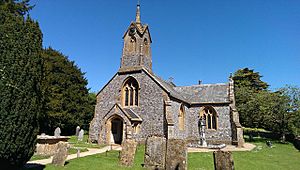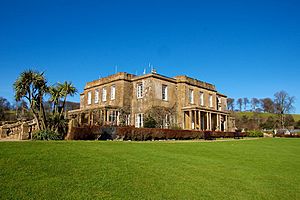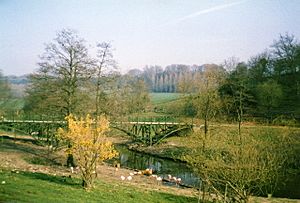Cricket St Thomas facts for kids
Quick facts for kids Cricket St Thomas |
|
|---|---|
 Church of St Thomas, Cricket St Thomas |
|
| Population | 50 (2011) |
| OS grid reference | ST375084 |
| Civil parish |
|
| Shire county | |
| Region | |
| Country | England |
| Sovereign state | United Kingdom |
| Post town | CHARD |
| Postcode district | TA20 |
| Dialling code | 01460 |
| Police | Avon and Somerset |
| Fire | Devon and Somerset |
| Ambulance | South Western |
| EU Parliament | South West England |
| UK Parliament |
|
Cricket St Thomas is a small village in Somerset, England. It is located in a pretty valley between the towns of Chard and Crewkerne. The village has a population of about 50 people.
Cricket St Thomas is well-known for its historic manor house, called Cricket House. This estate also used to be home to a popular wildlife park. The main A30 road passes nearby, making it easy to reach.
Contents
What's in a Name?
The name "Cricket St Thomas" has an interesting history. It comes from an old Anglo-Saxon word, "cruc." This word means a hill or a ridge. So, the name describes the village's location among hills.
A Look Back at the Manor's History
The history of Cricket St Thomas goes back a very long time. The village's manor was first mentioned in the Domesday Book in 1086. This was a huge survey of England ordered by William the Conqueror.
Over the centuries, the manor was owned by many different families. In the 11th century, it was held by the de Cricket family. Later, in 1775, a famous naval officer, Admiral Alexander Hood, bought the estate. He was a very important person in the British Navy.
Admiral Hood did not have children. So, he left the estate to his great-nephew, Samuel Hood, 2nd Baron Bridport. Samuel was married to Charlotte Mary Nelson, who was related to the famous Admiral Horatio Nelson. This connection brought a link to one of Britain's greatest naval heroes to Cricket St Thomas.
In 1898, the estate was sold to Francis Fry. He was a well-known chocolate maker.
How the Village is Governed Today
Cricket St Thomas has a parish council. This council helps manage local issues for the village. They decide on small local taxes to cover costs. They also check plans for new buildings and work with the police on safety. The council helps keep local footpaths and roads in good condition. They also care for the environment and historic buildings.
The village is part of the South Somerset district. This larger council handles things like bigger roads, rubbish collection, and parks. Somerset County Council manages even bigger services. These include education, libraries, and fire services.
The village is also part of the Yeovil area. This area elects one MP to the House of Commons in London.
The Church of St Thomas
The village has a beautiful church called the Church of St Thomas. It is a very old building, but it was mostly rebuilt in 1819-20. This means that most of the older parts from Saxon and medieval times are now gone.
Inside the church, you can find special monuments. These monuments remember the Nelson family and the Hood family. These families were important lords of the manor who lived at Cricket House for many years.
Church Monuments
Some of the interesting monuments in the church and churchyard include:
- Admiral Alexander Hood, 1st Viscount Bridport (1726-1814): This monument is on the church wall. It was designed by a famous architect named Sir John Soane.
- Alexander Hood (1814-1904): This monument is in the churchyard. It is a white marble statue of St Michael the Archangel. For a long time, the statue was laid down. This was because its white figure at night scared some local people!
You can also see a small piece of the altar cloth in the church. This cloth was used in the Coronation Service of Queen Elizabeth II in 1952.
Cricket House
The main building in the village is "Cricket House." It is a grand Georgian manor house built in 1786. Admiral Alexander Hood, 1st Viscount Bridport had it built. The same architect, Sir John Soane, who designed the Admiral's monument, also designed this house.
Today, Cricket House is a Warner Leisure Hotels resort. An old orangery (a type of greenhouse) attached to the house was once a parrot house. Now, it is used for bowling by the hotel guests. There is also a small garden house in the grounds called "The Admirals Seat."
Cricket House on TV
Cricket House became famous as "Grantleigh Manor" in the British TV show To the Manor Born. This comedy series was shown from 1979 to 1981. The writer of the show, Peter Spence, had a father-in-law who owned the house at the time.
Even though the show made the manor and its lodge look close, they are actually about 1.6 kilometers (1 mile) apart. The house was used again as "Grantleigh Manor" for a special episode in 2007.
Protecting Cricket House's Heritage
In 2009, the Cricket House estate was added to English Heritage's Heritage at Risk Register. This means that the historic site needed special attention. The development of the hotel and leisure facilities put some pressure on its historic features. Now, its vulnerability is considered 'Medium,' meaning it is still being watched.
Some parts of the grounds have been restored. This was done with help from a special environmental scheme.
The Former Wildlife Park
The old deer park of Cricket House was turned into a wildlife park. This park was once home to about 600 rare and endangered animals. These included lemurs, monkeys, camels, and many types of birds.
The wildlife park closed in 2009. Most of the larger animals were moved to other zoos. Some smaller animals, like the lemurs, stayed. The park then became beautiful gardens and lakes again. It reopened in 2010, but has since closed completely. Not much remains of the animal enclosures today.
Crinkley Bottom Theme Park
In 1994, the grounds of Cricket House also became home to a short-lived theme park called Crinkley Bottom. This park was created by TV presenter Noel Edmonds. It was based on the popular "Mr Blobby" character from his TV show Noel's House Party.
The theme park did not last long and closed within four years. Mr. Blobby's house, called 'Dunblobbin,' was at the back of the park. Other attractions included a TV-themed ride. Remains of Mr. Blobby's house could be seen until 2014, when it was finally taken down.




